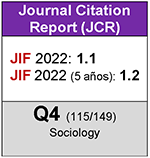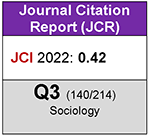Occupational segregation by sex. Evolution and situation in 2022
DOI:
https://doi.org/10.5477/cis/reis.191.129-140Keywords:
Census, Decomposed Dissimilarity Index (DDI), Economically Active Population Survey , Female-dominated Occupations, Lorenz Curve, Marginal Effects, Male-dominated Occupations, Multinomial RegressionAbstract
The state of occupational segregation in Spain in 2022 has been updated, and its evolution and determinants over the past century have been analyzed. This study relies on the most commonly used indices in the literature: the Gini Index (and Lorenz curves), the Dissimilarity Index, and the Decomposed Dissimilarity Index (which neutralizes the structure effect), referring to census data for greater detail. The determinants of segregation are examined using multinomial regressions and are compared with marginal effects (EPA, 2011 and 2021). The findings indicate that segregation has not significantly decreased; the weight of occupations having the highest levels of segregation has increased, while it has decreased in occupations that were already becoming integrated. Additionally, an inverse relationship between income and education is confirmed
in male –and female– dominated occupations.
Downloads
References
Ballesteros, Matías S. (2018). Promedio de los efectos marginales e interacciones en las regresiones logísticas binarias. Documento de Trabajo. Disponible en: https://www.aacademica.org/matias.salvador.ballesteros/43.pdf, acceso 29 de enero 2025.
Blau, Francine D.; Simpson, Patricia y Anderson, Deborah (1998). «Continuing progress? Trends in occupational segregation in the United States over the 1970s and 1980s». Feminist economics, 4(3): 29-71. doi: 10.1080/135457098338301
Buligescu, Bianca; Borghans, Lex y Fouarge, Didier (2020). «The impact of occupational segregation on occupational gender pay gap in the European union». Journal of Community Positive Practices, 4: 86-111. doi: 10.35782/JCPP.2020.4.05
CIS (2024). Percepción sobre la igualdad entre hombres y mujeres y estereotipos de género. Enero. Estudio 3428. Madrid: Centro de Investigaciones Sociológicas. Disponible en: https://www.cis.es/-/disponible-el-estudio-3428-percepciones-sobre-la-igualdad-entre-hombres-y-mujeres-y-estereotipos-de-genero-, acceso 29 de enero 2025.
Eurofound y European Commission Joint Research Centre (2021). European Jobs Monitor 2021: Gender gaps and the employment structure, European Jobs Monitor series. Luxembourg: Publications Office of the European Union.
Goldin, Claudia (2024). Carrera y familia. El largo viaje de las mujeres hacia la igualdad. Madrid: Taurus.
Ibáñez, Marta (2008). «La segregación ocupacional por sexo a examen. Características personales, de los puestos y de las empresas asociadas a las ocupaciones masculinas y femeninas». Revista Española de Investigaciones Sociológicas, 123: 87-122. doi: 10.5477/cis/reis.123.87
Ibáñez, Marta y Vicente, María R. (2017). Conceptos, medidas y evolución de la segregación laboral. En: M. Ibáñez (dir.). Mujeres en mundos de hombres: la segregación ocupacional a través del estudio de casos (pp. 15-33). Madrid: Centro de Investigaciones Sociológicas.
Ibáñez, Marta y Vicente, María R. (2020). «La segregación ocupacional por sexo. Evolución en España 2001-2011: diez años de caminar sin avanzar». Revista Española de Investigaciones Sociológicas, 171: 43-62. doi: 10.5477/cis/reis.171.43
INE (2001). Censo de población y vivienda 2001. Disponible en: https://www.ine.es/dyngs/INEbase/es/operacion.htm?c=Estadistica_C&cid=1254736177108&menu=resultados&idp=1254735572981, acceso 29 de enero 2025.
.
INE (2011). Censo de población y vivienda 2011. Disponible en: https://www.ine.es/dyngs/INEbase/es/operacion.htm?c=Estadistica_C&cid=1254736177108&menu=resultados&idp=1254735572981
INE (2021). Censo de población y vivienda 2021. Disponible en: https://www.ine.es/dyngs/INEbase/es/operacion.htm?c=Estadistica_C&cid=1254736177108&menu=resultados&idp=1254735572981
Karmel, Tom y MacLachlan, Maurine (1988). «Occupational Sex Segregation— Increasing or Decreasing?». Economic Record, 64: 187-95. doi: 10.1111/j.1475-4932.1988.tb02057.x
Magnusson, Charlotta (2013). «More women, lower pay? Occupational sex composition, wages and wage growth». Acta Sociológica, 56(3): 227-245. doi: 10.1177/0001699313484480
Mood, Carina (2010). «Logistic regression: Why we cannot do what we think we can do, and what we can do about it». European Sociological Review, 26(1): 67-82. doi: 10.1093/esr/jcp006
Perales, Francisco (2013). «Occupational sex-segregation, specialized human capital and wages: evidence from Britain». Work, Employment and Society, 27(4): 600-620. doi: 10.1177/0950017012460305
Rytina, Nancy F. (1981). «Occupational Segregation and Earnings Differences by Sex». Monthly Labor Review, 104(1): 49-53.
Siltanen, Janet; Jarman, Jennifer y Blackburn, Robert M. (1995). Gender inequality in the labour market: Occupational concentration and segregation. Geneva: International Labour Organization (ILO).
Sokoloff, Natalie J. (1992). Black Women and White Women in the Professions: Occupational Segregation by Race and Gender 19601980. New York: Routledge.
Downloads
Published
How to Cite
Issue
Section
License
Copyright (c) 2024 Revista Española de Investigaciones Sociológicas

This work is licensed under a Creative Commons Attribution-ShareAlike 4.0 International License.
Permite Compartir — copiar y redistribuir el material en cualquier medio o formato, Adaptar — remezclar, transformar y construir a partir del material para cualquier propósito, incluso comercialmente.








